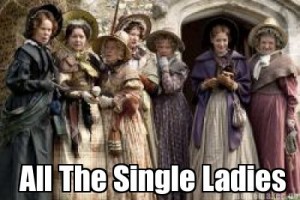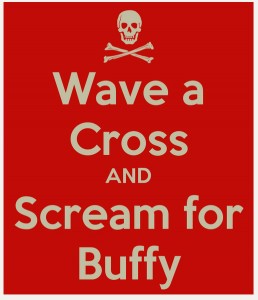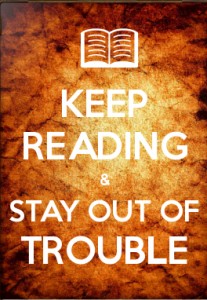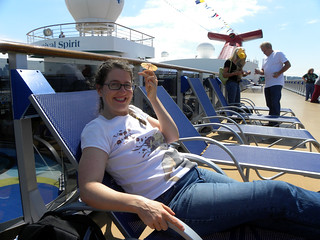 Some time ago we acquired the sequel to BBC’s Cranford
Some time ago we acquired the sequel to BBC’s Cranford , which is as chickly a televisual enterprise as you would ever want to watch. Based on fiction by Elizabeth Gaskell, it was produced and created by Sue Birtwhistle and Susie Conklin, and stars Judi Dench, Julia McKenzie, Imelda Staunton, Barbara Flynn and Julia Sawalha.
, which is as chickly a televisual enterprise as you would ever want to watch. Based on fiction by Elizabeth Gaskell, it was produced and created by Sue Birtwhistle and Susie Conklin, and stars Judi Dench, Julia McKenzie, Imelda Staunton, Barbara Flynn and Julia Sawalha.
Also, it has a cow in long underwear.
I’m not saying it’s all one big convent, or even L Word, 1840 Style . (Though that might be intriguing). There are men in the town of Cranford, you see. It’s just that few of them seem to be available for traditional heterosexual romantic pursuit. They’re either attached or bound for India, or just plain dim or somehow doomed.
. (Though that might be intriguing). There are men in the town of Cranford, you see. It’s just that few of them seem to be available for traditional heterosexual romantic pursuit. They’re either attached or bound for India, or just plain dim or somehow doomed.
So this wonderful bunch of middle-aged spinsters who pretty much own the town bevvies about, not being married, not having children and instead forming a delightful alternate family. They putter about gossiping and having adventures and renovating theaters and, now and then, experiencing heartbreak as they grapple with the clash between the era they grew up in and their radically changed present, with its railroads and progress and newfangled technology.
Part one was so wonderful and that we rewatched it before diving into Return to Cranford . The original series had neatly disposed of the only two single men by its final episode. One did, despite considerable deficits in the commonsense department, get himself married. The other, who was played by a delightfully surly Philip Glenister, did not. They shuffled him off the stage nonetheless.
. The original series had neatly disposed of the only two single men by its final episode. One did, despite considerable deficits in the commonsense department, get himself married. The other, who was played by a delightfully surly Philip Glenister, did not. They shuffled him off the stage nonetheless.
Even a chickly chickly costume drama’s nothing without at least one romantic entanglement, am I right? So one new male character now was required. So, to my surprise, the new available boy turned out to be the man otherwise known as Loki McWhinepants, brother of Thor–in other words, Tom Hiddleston.
Now many of my fannish friends have the idea that Tom Hiddleston and his Avengery alter ego are as yummy a bag of chips as the salt gods could ever bestow upon a screen, big or small. And I could, intellectually, rationalize his appeal. But film Loki just didn’t do it for me. If there was a test whose question was Rate the Film Avengers in order of sexy yum potential, my list would probably go something like this:
in order of sexy yum potential, my list would probably go something like this:
1. Joss Whedon’s Brain
2. The Assassins.
3. Tony.
4. Bruce.
4.5. Tony and Bruce, together, in that car. Or that lab.
5. Team Shield: Fury, Agent Coulson, Agent Hill and their very cool ship.
6. Captain America.
7. Unnamed but suitably grateful Waitress.
8. Team Asgard
9. Pepper
What I’m saying is that while I’ve understood and (I hope) supported my friends in their pursuit of Tony/Loki fanfic and ever cuter Hiddleston gifs, I’d also thought, you know, yawn.
What’s this got to do with our topic (Return to Cranford , remember? It’s okay. I almost forgot, too.) Well, Tom Hiddleston! In period Pants! Being earnest and put upon and in pure true love with a young woman and being put upon by his father. In the face of parental opposition to his life choices, he does something that’s spoilery spoilery never you mind but thoroughly wonderful and romantic.
, remember? It’s okay. I almost forgot, too.) Well, Tom Hiddleston! In period Pants! Being earnest and put upon and in pure true love with a young woman and being put upon by his father. In the face of parental opposition to his life choices, he does something that’s spoilery spoilery never you mind but thoroughly wonderful and romantic.
And just like that, Whoo! I’m on board.
In my house, silly new telecrushes inevitably lead first to the imdb. . .
. . . and then to embarrassment, in this case because I then realized that TH was also the totally annnoying Magnus in Wallander . I love Wallander
. I love Wallander ! How did I miss that?
! How did I miss that?
(Answer: I was too busy laughing as little Kenny Branaugh cried his eyes out. Apparently I am a sick sick person).
. . . and then, after the Wallander discovery and subsequent facepalms had sunk in, all I could do was text the aforementioned Tony/Loki shipper to say guess what, I heart what you heart now. You are right, I am wrong, mea culpa.
discovery and subsequent facepalms had sunk in, all I could do was text the aforementioned Tony/Loki shipper to say guess what, I heart what you heart now. You are right, I am wrong, mea culpa.
So I’ve learned a valuable lesson about tolerance, or perhaps about how Mister Hiddleston is far more attractive when clothed in old timey garb, virtue, and clean hair. But what I really hope you’ll take away from this is that Cranford and sequel are all about the women. If you like costume dramas at all and someone missed this one, I recommend it bigtime. Especially as Judi Dench is so warm and lovely and thoughtful and thoroughly marvelous that you just want to reach through the fourth wall and give her a great big hug. Plus, also, tea.
are all about the women. If you like costume dramas at all and someone missed this one, I recommend it bigtime. Especially as Judi Dench is so warm and lovely and thoughtful and thoroughly marvelous that you just want to reach through the fourth wall and give her a great big hug. Plus, also, tea.
 I will be at FanExpo Vancouver this weekend, signing books and meeting fans. Including some of you, perhaps? I hope so.
I will be at FanExpo Vancouver this weekend, signing books and meeting fans. Including some of you, perhaps? I hope so., Hiromi Goto, whose Half World
won the Sunburst Award in the youth category in 2010, the same year Indigo Springs
received the Sunburst for adult fiction–we’re like Sunburst Twins! Eileen Kerneghan and Silvia Moreno-Garcia will be there too.







